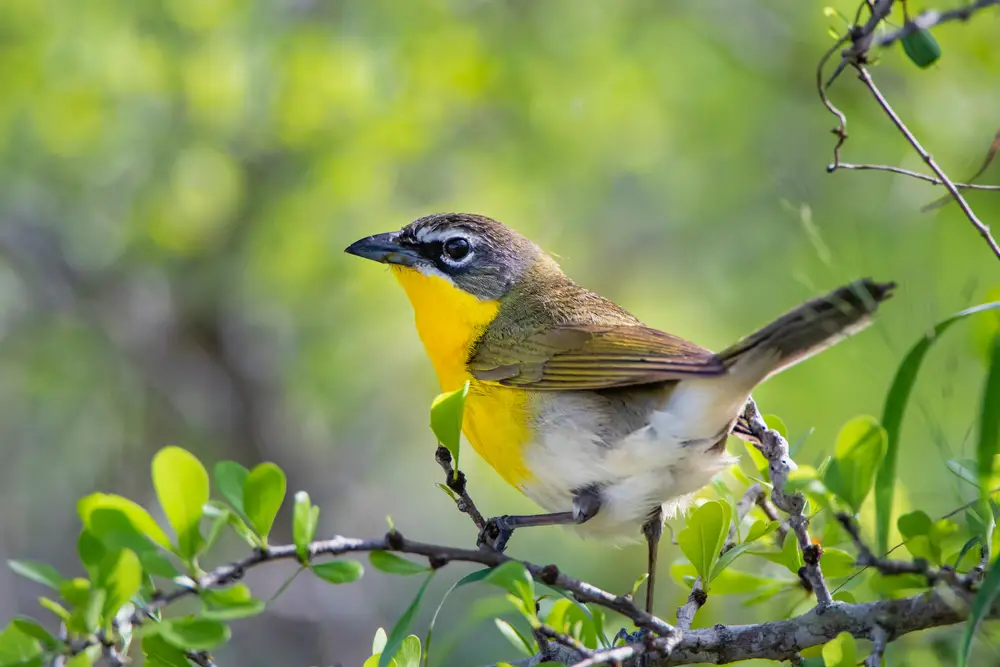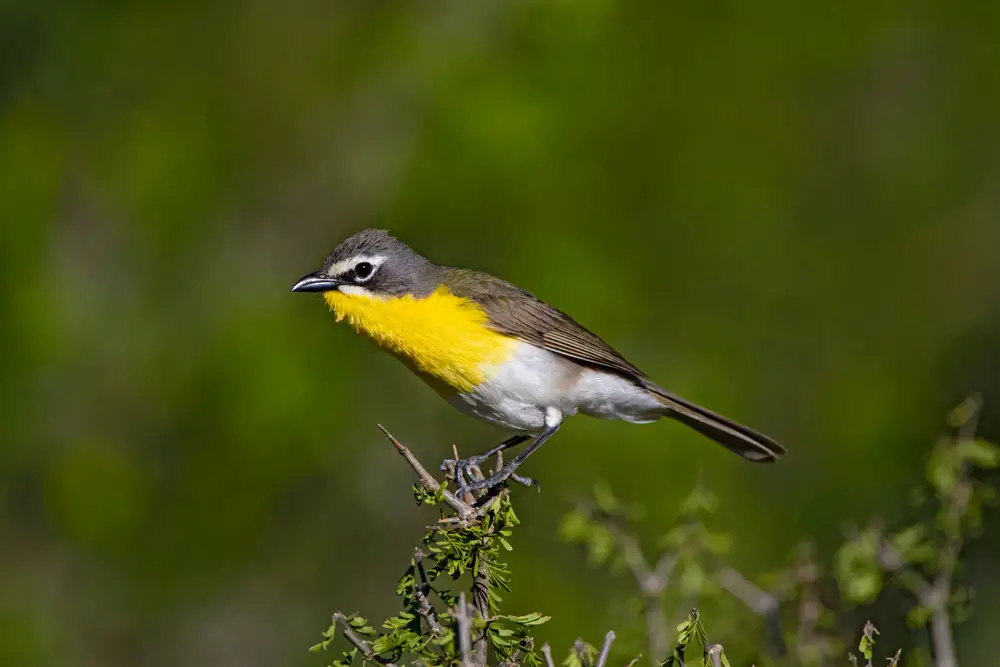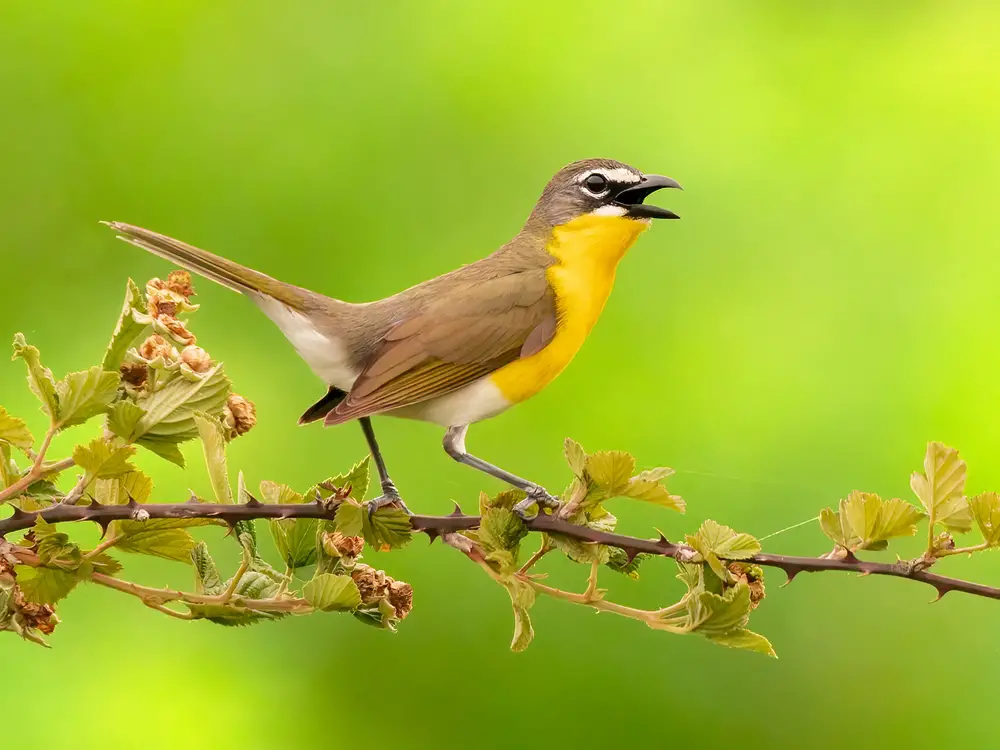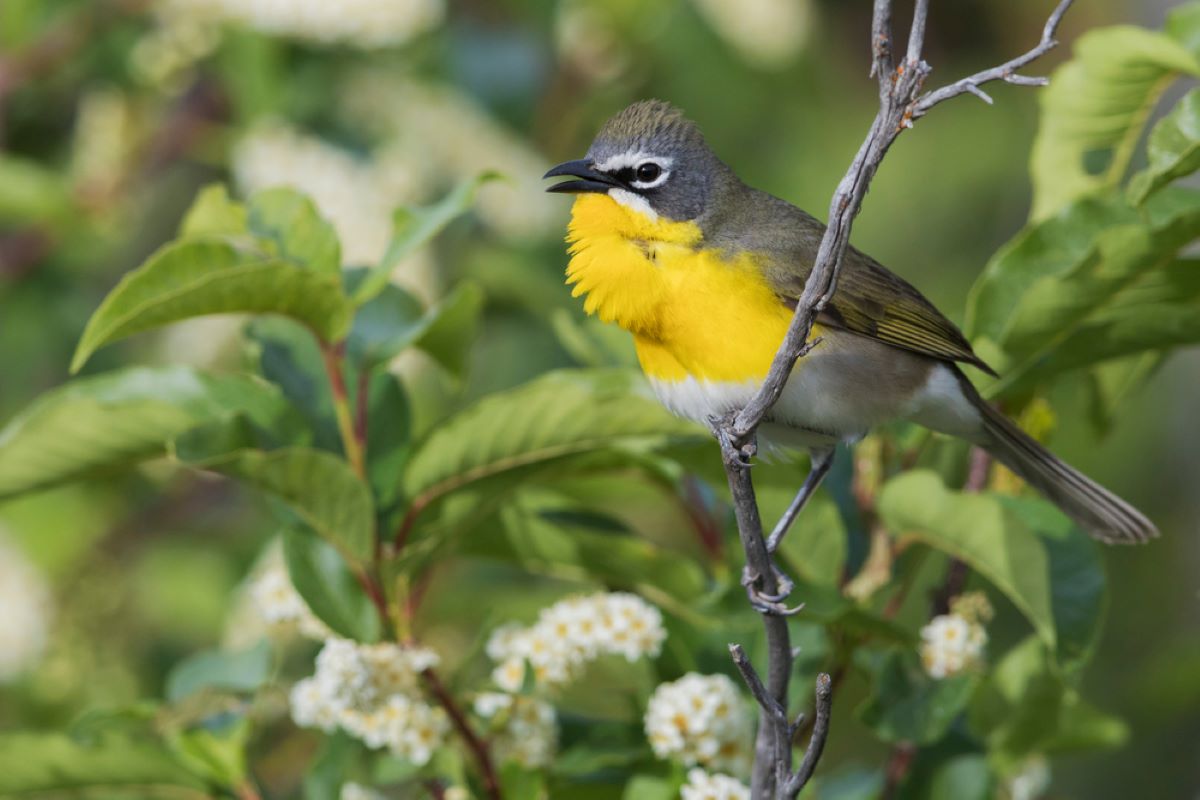The yellow-breasted chat is a North American songbird known for its chatty, eclectic call. This beautiful songbird has an impressive vocal catalog and lots of interesting physical features. The sound of the yellow-breasted chat is a mix of cackles, gurgles, hoots, whistles, and trills.
The yellow-breasted chat is one of the more elusive North American songbirds. Known for skulking in dense underbrush and tangles of vegetation, this shy songbird is more often heard than seen. Their extensive catalog of sounds rivals that of the mockingbird and can be heard throughout most of the Spring and Summer.
Male vocalizations are varied and sung loudly during mating and breeding season. They sing to defend territory and also to woo prospective mates. While their vocalizations are impressive, the flight song display is one of the most interesting behaviors of the yellow-breasted chat. We’ll chat about this beautiful songbird’s vocal habits and share some facts and features about this remarkable and rarely seen bird!
What does the yellow-breasted chat song sound like?
The yellow-breasted chat song is a series of several different hoots, cackles, gurgles, trills, catcalls, tweets, and whistles. The unique vocalizations vary wildly between chats. They even have a special flight song to catch female chats’ attention during mating season.
Yellow-breasted chats (Icteria virens) are talented singers. Like the mockingbird, they switch from one sound to the next, improvising as they go. While some songbirds with large catalogs struggle to recognize the song of neighboring birds, yellow-breasted chats are clearly able to recognize the song of known yellow-breasted chat. This saves them the trouble of investigating other yellow-chats and engaging them in territorial fights.
The flight song of the yellow-breasted chat is perhaps one of the most interesting behaviors of this large songbird. Males will fly into the air, singing loudly and flapping their wings. Their wingbeats add to the song, further enticing female chats and letting other males know this is their territory. While yellow-breasted chats spend much of their lives skulking in bushes, this bold, loud flight song is a fantastic sight for bird watchers lucky enough to catch the display flight in action!

How do you identify a yellow-breasted chat?
Yellow-breasted chats have gray upperparts and a bright yellow throat and breast. Bright white lines circle their eyes like glasses. They have a white stripe from their nostrils to their eyes, with a thin black line running from below the eyes and along the top of the beak. Their underparts are light to whitish gray.
While many say this heavy-bodied songbird looks like a cross between a mockingbird and a warbler or tanager, that description really doesn’t do this bird justice. Along with their boldly marked head, the yellow-breasted chat has more than a few attractive physical features. Their wings and tail are reddish-gray with yellow highlighting. In flight, the underside of their wings are bright yellow with gray flight feathers.
Their lifespan is about 5-8 years, but they can live much longer in the right conditions. The oldest living yellow-breasted chat was recorded in 2016. Found in Arizona, this female chat was confirmed to be nearly 12 years old!
What habitat does the yellow-breasted chat live in?
The yellow-breasted chat is found in riparian areas throughout North America. They spend breeding season in the eastern United States, western United States, along the Canadian border, and inland Mexico. Yellow-breasted chats live in rural areas and abandoned farms, and anywhere else, an overgrowth of vegetation is present.
During the winter months, they will migrate to the coastal regions of southern Mexico and into Central America. Avid foliage gleaners, these bright yellow birds prefer dense shrubs, thickets, and tangles of unpruned brush for hunting insects.
While these beautiful songbirds are widespread, their habit of hiding in thickets and other dense foliage makes them harder to find. Bird watchers will often hear their bird song before they see them. With a bit of patience, bird watchers in fact can catch sight of a skulking yellow-breasted chat coming out of their hiding place.

When is the yellow-breasted chat breeding season?
The yellow-breasted chat breeding season is from April to May. Chats in warm southern states may breed into early September. Chats are semi-monogamous, largely due to the female chat’s aggressive guarding against other females. Surprisingly, it’s the female chat that may stray, with up to 1/5 of the nestlings a female chat raises sired by a different male.
Yellow-breasted chats build their thick cup-shaped nest in dense vegetation using plant material lined with soft grasses and animal hair. Each female chat has 1-2 broods with up to 6 eggs. The speckled white eggs hatch after a 10-12 day incubation.
Female chats do most of the work, incubating and caring for the hatchlings. As they grow, the male will help feed the nestlings soft-bodied insects like caterpillars and grubs. Young chats remain in the nest until they are about 10 days old, with some fledglings leaving as early as their 7th day.
Habitat restoration has made a positive impact on the yellow-breasted chat population. Unfortunately, brood parasitism by cowbirds continues to reduce the number of yellow-breasted chat nestlings that survive each breeding season. Cowbird nestlings stomping on eggs also prevents hatching. Some yellow-breasted chats will abandon a nest that cowbirds have infiltrated, but far too many will raise the cowbird young as their own.

What songbird family does the yellow-breasted chat belong to?
As of 2017, the yellow-breasted chat belongs to the family Icteriidae. Despite that change, the taxonomy of the yellow-breasted chat remains complicated. They were once considered the largest of the Parulidae family, or New World Warblers. While they remain in the Icteriidae family, there is still a lot of disagreement among scientists about this classification.
The yellow-breasted chat is the sole member of the family Icteriidae, which belongs to the order, Passeriformes. The family name (Icteriidae) is similar to the blackbird family (Icteridae) . They are considered to be more closely related to blackbirds than warblers. In fact, many ornithologists argue they should be moved to the family Icteridae rather than having their own family.
Yellow Breasted Chat Summary
Yellow-breasted chats are quite an amazing songbird. Known in French as Ictérie polyglotte, this talented singer truly is a bird of many sounds. If you’re lucky enough to actually catch the vibrant vocalizations during breeding season, be sure to watch the skies for the flight song display.
Outside of breeding season, listen for fussy chatters from dense vegetation, a sure sign that chats are nearby. If you’re patient, you might get to check a sighting of this wonderful songbird off your bird-watching bucket list!

